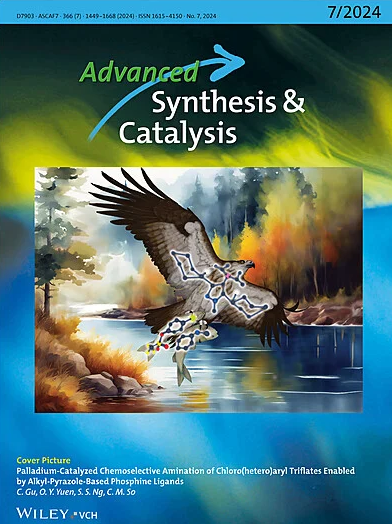用无膦钌二胺催化剂催化四氢γ卡泊啉衍生物的不对称加氢反应
IF 4
2区 化学
Q2 CHEMISTRY, APPLIED
引用次数: 0
摘要
在不含膦的钌二胺催化剂催化下,开发了一种高效的四氢- γ -羰基衍生物的不对称加氢反应,得到了具有优异对映选择性和非对映选择性的顺式六氢- γ -羰基衍生物(高达99% ee和20:1 dr)。此外,该催化方案适用于克级合成心脏保护药物(‐)‐斯托巴丁。本文章由计算机程序翻译,如有差异,请以英文原文为准。
Asymmetric Hydrogenation of Tetrahydro‐γ‐Carboline Derivatives with Phosphine‐Free Ruthenium Diamine Catalysts
A highly efficient asymmetric hydrogenation of tetrahydro‐γ ‐carboline derivatives catalyzed by phosphine‐free ruthenium diamine catalysts has been developed, providing the corresponding cis ‐hexahydro‐γ ‐carbolines with excellent enantioselectivities and diastereoselectivities (up to 99% ee and >20:1 dr). Furthermore, this catalytic protocol is applicable to the gram‐scale synthesis of cardioprotective drug (‐)‐stobadin.
求助全文
通过发布文献求助,成功后即可免费获取论文全文。
去求助
来源期刊

Advanced Synthesis & Catalysis
化学-应用化学
CiteScore
9.40
自引率
7.40%
发文量
447
审稿时长
1.8 months
期刊介绍:
Advanced Synthesis & Catalysis (ASC) is the leading primary journal in organic, organometallic, and applied chemistry.
The high impact of ASC can be attributed to the unique focus of the journal, which publishes exciting new results from academic and industrial labs on efficient, practical, and environmentally friendly organic synthesis. While homogeneous, heterogeneous, organic, and enzyme catalysis are key technologies to achieve green synthesis, significant contributions to the same goal by synthesis design, reaction techniques, flow chemistry, and continuous processing, multiphase catalysis, green solvents, catalyst immobilization, and recycling, separation science, and process development are also featured in ASC. The Aims and Scope can be found in the Notice to Authors or on the first page of the table of contents in every issue.
 求助内容:
求助内容: 应助结果提醒方式:
应助结果提醒方式:


